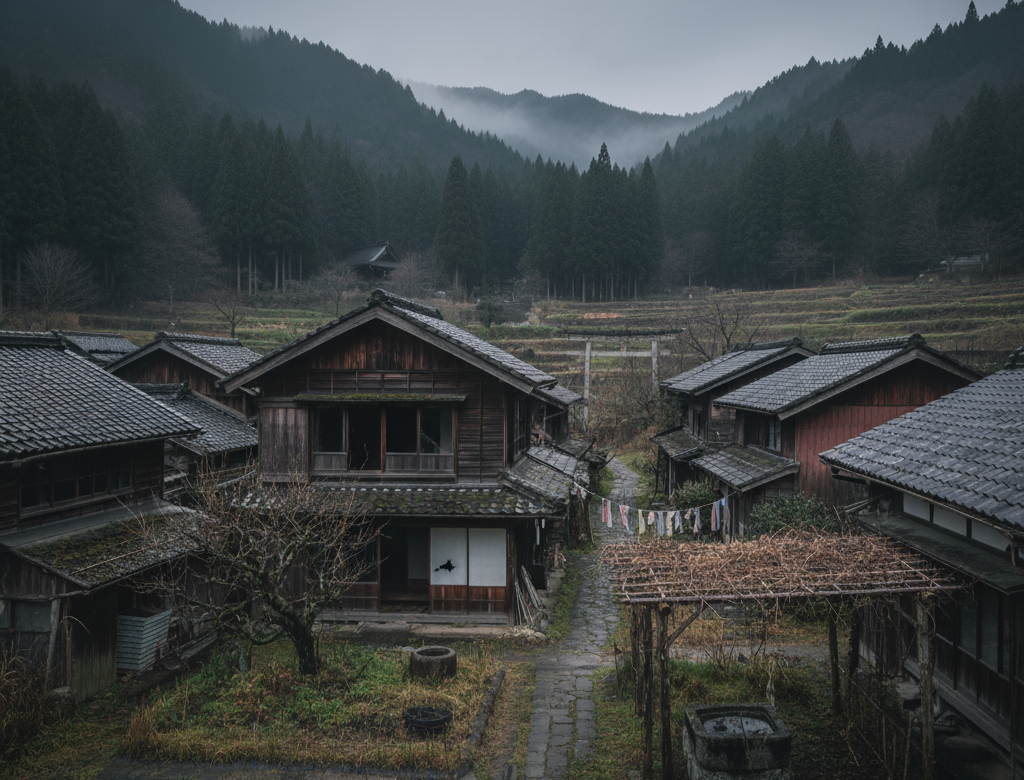In the rural regions of Japan, a few scattered houses remain, swept away by time along with the dust carried by the wind. Their windows are darkened, doors ajar, and earthen walls are covered by wild grasses mixed with the garden weeds. These houses are “akiya”—vacant homes. They are not merely unused structures; they hold the accumulation of life, labor, and years within them. They are also concrete traces of how a society is changing and how village life is silently retreating.
What the Silent Streets Tell
The streets that once woke up to the crowing of roosters at first light are now almost silent. The water bowl in front of the houses is empty; the garden trees are unpruned, and the wooden arbor, where a grapevine once hung, carries a sadness mixed with the mulch. These physical traces are micro-scale reflections of a large demographic transformation: the migration of youth to the cities, the falling birth rates, and the increase in the elderly population.
Every akiya tells a story: photographs left behind by a couple who migrated, the diary of a woman who lived alone, a class roster from years ago hung on the door of the village school… These items are not just memories to be lost when thrown away; they are also a part of the collective societal memory. As houses empty, the rhythm of neighborhood ties is disrupted; the echo of local conversations, shared harvest days, and communal ceremonies begins to fade.
The Erasure of Cultural Traces
Village life is not merely about shelter. Seasonal rituals, village festivals (matsuri), communal farming practices, mutual aid among neighbors—these are the cultural networks that sustain a community. The increase in vacant homes means the weakening of these networks.
Votive offerings left near the temple, hand-woven textiles, wedding garments hidden in the ceilings of old houses; all are embodied traces of cultural practice. As houses are demolished or left derelict, the transmission of these practices is severed; younger generations are deprived of the opportunity to learn the stories told by their grandparents, the crafts, or the regional recipes.
Human Stories: The Lost Voices
The owners of some akiya are still alive but live far away in the city, in a hospital, or a nursing home; others are forgotten amidst buried funerals and fragmented inheritance files. A mother who was born and raised in the village but whose children decided to live in the city says, “The last time I went home, it felt as if there was still warm food on the table; but even if no one came, the house would get cold again.” Another elderly man, pausing while plowing his field in the last days when everyone was gone, quietly says, “This place is no longer just lonely, it is abandoned.” These small confessions reveal the human face of the great loss: loneliness, a void of belonging, and the thinning of the connection to the past.
Hope and Efforts for Rebirth
Despite all this sorrow, vacant homes can also be places for new beginnings. Local initiatives, platforms like “akiya banks,” and restoration projects started by young people are transforming abandoned houses into studios, guesthouses, or shared living spaces.
Some towns are showing examples of revitalization by encouraging the repair of old houses and attracting interest to the region through festival events. These efforts are not only a physical restoration but also a remembering of forgotten stories, recipes, and craftsmanship.
Preserving Memory, Preserving Community
Akiya are not just empty residences; they are the spatial projections of a culture, a memory. To preserve or transform them is not merely to solidify stone walls, but to protect the social fabric, the rituals, and the collective memory of the community. The silent streets of rural Japan offer us a warning and an invitation: to remember the past, connect with the present, and seek new paths for tomorrow. Every akiya can live again in the right hands, provided we listen to the history of that home.

